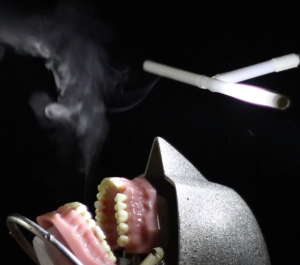Update:
The Air-Curtain-Goggles are now for sale.
We make our scientific and technical know-how available to scientific institutions and companies free of charge.
Please contact us for further information. luftvorhang@dentazoom.de
The Project SuperSonic Air Separation System
Aerosols rise unhindered from the patient through breathing, speaking or coughing, and the thermals transport the aerosol clouds directly to the treating person. With the “air curtain” the aerosols are prevented from rising and at the same time discharged.
The “dental SuperSonic” project was born Due to the great demand and many suggestions, we have developed another variant. The nozzle tube is attached to patient goggles. The handling has now been optimized again.
Download the Video
26.10.2020
Added to protection glasses. Simple to use und more space for the dentist.
The treatment situation in dentistry is very problematic with regard to corona.
At a distance of 25 cm from the mouth of the dentist to the mouth of the patient, considerable virus concentrations can occur. Only as a small calculation example: If the concentration in 1.5m is considered unproblematic, then at a distance of 25cm (i.e. one sixth), you have a 6x6x6 = 218 times the concentration. Without any further protective measures, the patient and the person treating the patient “breathe” for each other. Closer examination: https://www.medrxiv.org/content/10.1101/2020.08.31.20185439v1.full.pdf+html
What FFP2 masks can do here is written in the stars; it is not known whether 95% filter performance with a powerful spreader will have the desired effect.
However, I was shocked by the theoretical investigations of Peric & Peric.
->Here is the summary of the study
->Here you can download the whole study as PDF
Minimal edge leakage, well below one millimetre, which should be the rule in practice for a one-hour treatment, quickly brings the total leakage above 50%.
From this, the idea of developing a second barrier was born.
Large-volume suctioning does not seem to be a practicable way. This would require industrial vacuum cleaners, which hardly allow normal work. The usual suction systems can certainly do a lot in the immediate vicinity of the teeth, but they will have little effect on the exhaled air through the nose. Blowing away, with the head/foot direction, is a sensible idea. In practice, however, there are some problems: The speed of diffuse blowing must be kept quite low…Fans with HEPA become quite large…
Professor Milovan Peric then gave me the idea of creating an air curtain that creates a separation between the practitioner and patient.
In practice, it now looks like this at the prototype stage: See picture of the idea above.
-The compressor available on all ZA units is used to supply compressed air. Usual performance data are: 5Bar, 1000Watt but only 2l/s of output air.
-In order to reduce the air output to 0.3-0.5 l/s, 15 small diameter nozzles are suitable. The nozzle rod/arc is fixed about 5cm above the lying patient, above the forehead area. According to the measurements, the holes create a cone of 20-30 degrees, and hardly irritate the patient, noises seem to be well bearable.
The measured air flow velocity is 2 m/s at a distance of 15 cm.




